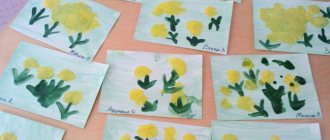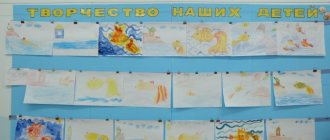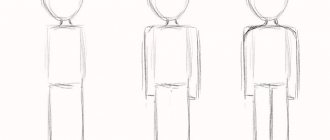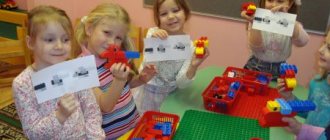GCD for non-traditional drawing in the middle group Topic: “Winter's Tale”
Transcript
1 GCD on non-traditional drawing in the middle group Topic: “Winter's Tale” Direction: artistic and aesthetic Goal: to master the methods of drawing with a thread Objectives: to develop interest in non-traditional images on paper. Educational: arouse children's interest in winter natural phenomena, develop the ability to draw with a thread, and develop a sense of composition. Developmental: develop fine motor skills of the hand, visual observation, imagination and imagination of the child. Educational: to cultivate neatness while working. Progress of GCD 1. Organizational moment: Children sit on chairs, the Snow Maiden enters to the music. Snow Maiden: The white blizzard is spinning and spreading, Covering the stitches and bridges with whiteness. Along the alley I walk Snow Maiden. From the fairy-tale mansion I appeared. -Hello guys! By the time I got to you, I was frozen! Were you cold when you went to kindergarten today? - Why, what time of year is it now? — Is the weather outside consistent with autumn? Children's answers: - Why did you decide that it was winter? Children's answers: Snow Maiden: - Children (I ask the child), what can you call the weather when snow falls? Is there a strong wind blowing and snow swirling in the air? (blizzard, blizzard, blizzard) - Guys, I have a surprise for you - an excerpt from the cartoon “The Snow Queen”, where you will see how a blizzard blows and a blizzard sweeps. (Guys, pay attention to how the blizzard draws patterns) (showing a cartoon) - Children, can you repeat the blizzard song? “Uuuuuuuuuuuuuuuuuuuuuuuuuuuuuuuuuuuuuuuuuuuuuuuuuuuuuuuuuuuu” - How does a snowstorm blow? “Sh-sh-sh-” Children, what a great fellow you are, the blizzard and blizzard turned out well for you. Music (I'm telling a fairy tale) Do you like fairy tales? Listen to one fairy tale. Once upon a time there lived a grandmother Vyuga, she had a beautiful winter shawl decorated with snowflakes. (show). At night, snowflakes rested on Grandma Vyuga’s shawl. When Grandmother Vyuga woke up, she took her shawl and shook it, then the snowflakes flew apart in a dance. (Shaking the shawl) - Why do you think the snowflakes scattered? -What are they?
2 Guys, all the snowflakes scattered, and Grandma Vyuga’s shawl was left without patterns. And not at all as beautiful as she was. What should we do now? You and I, too, can turn into snowflakes. 2. Physical education is held (to music) We are white snowflakes, flying, flying, flying! We'll cover the paths and paths with snow. Let's circle over the garden on a cold winter day, And sit quietly next to people like us! Snow Maiden: come up and place Grandma Vyuga’s snowflakes on the shawl. Well done guys, they helped Grandma Vyuga. Snow Maiden: Children, you told me that winter will come soon! — What long-awaited, beloved holiday is approaching? Children's answers - Who is the main character at the New Year's party? Voice of Grandmother Vyuga: -Guys! Help me please! The holiday is approaching. And in our forest the animals have nothing to decorate the New Year tree with. Help me please! Snow Maiden: Shall we help Grandmother Vyuga? Then come to the table. Whose birthday did we celebrate last week? Who came to visit us? And so he left snowflakes, and on the snowflakes we will draw winter patterns, and not simple patterns, but with the help of magic threads. 3. Preparation for the activity process Before we start drawing, we need to stretch our fingers. 4. A finger game is being played. Our fingers can do everything, they can do everything, they can help everyone. Fingers can draw, you just need to stretch them. Finger pads - draw cheesecakes. Our fists draw pies. (they clap their fists on their palms) And we draw palms, (they move their palms up and down) The drawings are simply top class! (show thumb) 5. The process of the Snow Maiden’s activity: Guys, take the thread by the knot and, without letting go, dip it into the paint, and you choose the paint yourself, the one you like best, take it out, shake the extra drops and draw a pattern on the snowflake, then cover it with a clean piece of paper , pressing lightly with your palm. And while you are holding the leaves with your palms, I will say the magic words: “Lie down, soft snows, on the forests and meadows, Cover the paths, feather the branches Easy knowledge, cunning plexus.”
3 (Children draw to the music) - what patterns did you get? (beautiful, fabulous) You are all just great! Guys, let's decorate our Christmas tree with them and let everyone see what snowflakes we made! Do you like it? (children decorate the Christmas tree). Recording of Vyuga's voice. (Music sounds) Thank you! Guys! You fulfilled my request, you made charming snowflakes, I really liked them and are looking forward to seeing them in our forest. - Children, how are we going to send them to the forest? Children Okay, we will do this, you can pass it on to me. Snow Maiden: Guys, Grandma Vyuga was pleased with your drawings. And I really liked your work, but it’s time for me to say goodbye to you. Thank you! Goodbye!!! Until next time.
4 Self-analysis Direct educational activities on artistic and aesthetic development. Topic: "Winter's Tale". The abstract was developed in accordance with the program of artistic education, training and development of children 2-7 years old “Colored Palms” by I.A. Lykova, I used the teaching aids “Drawing without Brushes” by I.A. Lykova. Why an unconventional drawing method, because its use helps children feel more relaxed, bolder, more spontaneous, develops imagination, and gives complete freedom for self-expression. In addition, work contributes to the development of coordination of movements. The child loves to quickly achieve results in his work, and unconventional techniques contribute to this. The lesson is complex, combines educational areas: cognitive development, speech development, social and communicative development, artistic and aesthetic development, physical development, which corresponds to the age and psychological characteristics of children in the middle group. Taking all this into account, I set a goal: to master an unconventional method of drawing with threads. When planning the GCD, I set the following tasks: Educational: to develop the ability to draw with gouache using an unconventional technique - strings. Developmental: develop fine motor skills of the hand, visual observation, imagination and imagination of the child. Educational: cultivate positive motivation, accuracy during work, promote active interaction between children and the teacher. Included the integration of educational areas: “Speech development”: development of an active vocabulary on the topic, development of free communication with adults and children, pronunciation of the sounds “U”, “W”. “Cognitive development”: consolidate the ability to navigate on a sheet of paper. “Physical development”: physical education, finger game “Our fingers can do anything.” “Social-communicative”: the formation of friendly relationships between children. “Artistic and aesthetic development”: drawing with threads. To achieve the set goals, the following structure was used: 1st organizational stage provided psychological preparation and emotional state of preschoolers. At this stage, I created an emotional mood through the surprise moment of the appearance of the Snow Maiden, showing a cartoon, telling a fairy tale; expanded the children's vocabulary (blizzard, blizzard). Stage 2: formation of skills and abilities.
5 At the second stage, she organized a ratiometric pause, used the formulation of a problem situation, during the solution of which she unobtrusively led the children to the practical work of drawing with strings. Used visual, verbal and practical methods aimed at using speech, cognitive, motor, practical skills and abilities and improving them. Musical accompaniment enhanced emotional perception. For each moment of the lesson, I selected visual aids that stimulated and activated the children’s mental activity. Emotionally supported the children by encouraging the successes they achieved, instilled a sense of collectivism and cohesion. Analyzing the GCD, we can say that the assigned tasks were successfully completed. The plot of the educational activity did not bore, but aroused curiosity and allowed us to combine all types of activities, which created a positive mood, and also contributed to increasing the effectiveness of the lesson.
Middle group. Junior preschool age. Children 4 - 5 years old
Development of fine motor skills in children of primary preschool age through non-traditional drawing techniques Lesson summary on the topic: "Development of fine motor skills in children of primary preschool age through non-traditional drawing techniques " Goal: To develop fine motor skills in preschool children through plasticineography. Educational objectives: - to develop the ability of children...
Work program for the circle of non-traditional drawing techniques in the middle group of the preschool educational institution Municipal budgetary preschool educational institution "Kindergarten "Smile"
APPROVED by the Head of MBDOU “Kindergarten
“Smile”
V. B. Kubyshkina Order No.
“”
2021 Work program Club on
non-traditional drawing techniques “Fun watercolor”
Completed by: Ruzhnikova T. V....
Summary of GCD for drawing in the middle group on the topic: Decorative drawing “Decorate your toys.”
Tasks. Continue to introduce children to Dymkovo toys, teach them to note their characteristic features, and highlight the elements of the pattern: circles, rings, dots, stripes. Develop aesthetic perception, sense of rhythm, composition, color. To cultivate independence, the ability to complete the work started, to instill love and respect for the work of folk craftsmen. Pay attention to the close connection between folk traditions, music and oral folk art.
I.O.O .: H.-E. R., P. R., R. R., S.-K. r., F. r.
Materials. Theater toy bi-ba-bo Parsley. Illustrations of Dymkovo toys. Gouache paints of different colors, album sheets with patterns of Dymkovo toys, brushes, jars of water, napkins (for each child).
Vocabulary work: Dymkovo toys, pattern, ring, circle, straight and wavy line, elegant, festive, clay.
The beginning of GCD.
Petrushka appears to a Russian folk dance melody:
— Guys, a package has arrived at our kindergarten from the village of Dymkovo. The Dymkovo masters sent it to us. Want to know what's in it? Let's open it.
Oh, there are some white toys and a letter: “Dear guys! Craftsmen from the village of Dymkovo are writing to you. We'll have a fair soon, but we don't have time to paint our toys. Help us, please - paint these toys with Dymkovo painting and send them to us.”
- Yes, guys, a difficult task! Could we? Can we cope? After all, being a master is not an easy task! Do you want to become masters? Will you paint the toys? Well, then let's get started.
Main part.
1. Examination of Dymkovo toys.
- Do you know what these toys are called? Why are they called that? Why was the village called Dymkovo? That's right, because in winter, when the stoves are lit, and in summer, when there is fog, the village seems to be in a haze.
People lived in that village. When it was cold outside and the winter frost froze the ground, the stoves in the houses were flooded, smoke enveloped the roofs, so much so that nothing was visible, just smoke. So they named the village Dymkovo. The adults in that village worked from morning until late evening: they sowed grain, prepared food, grazed domestic animals: cows, lambs, horses, sheep, and went fishing. And the children played in the meadow and sang songs. And the adults began to think, what can they do to please the children? They collected clay from the river bank, kneaded it like dough and began to sculpt it. At the beginning they made a lot of whistles, molded them, fired them in a kiln, covered them with white chalk, and then painted them with bright colors and gave all the whistles to the children. The children had a lot of joy playing the whistles.
Guests from other villages came to the village of Dymkovo and asked people to make such toys for their children too. And the Dymkovo craftsmen began to sculpt more and more, more and more beautiful, and not only whistles, but various figures. And young ladies, water-carriers, gentlemen, carts with horses, hussars, deer, goats, fish, cockerels, hens with chicks and many, many other toys appeared. This is how the craftsmen from the village of Dymkovo became famous for their toys throughout our country, throughout Russia!
How elegant these toys are, bright and with patterns. Guys, what patterns are these toys decorated with? Circles, rings, stripes, wavy lines. Do you know that there is a secret in these elements: the circle means the sun, the wavy lines mean water, and the intersection of straight lines means the earth.
2. Showing a sample by the teacher.
— Guys, remember how to work when painting. Before picking up another paint, you need to rinse the brush, and only then take another paint. Now we draw dots with the tip of the brush. We draw stripes by applying a brush to the paper. Come up with your own pattern, just don’t forget that the elements of the pattern must be the same. And think over a combination of colors to make the toys bright and beautiful.
In the meantime, let's take a little rest and do some exercises for our fingers:
3. Finger gymnastics.
They are friends in our group (Clap their hands.)
Girls and boys.
You and I will become friends (They knock their fists against each other.)
Little fingers.
One, two, three, four, five (Bend the fingers one by one, starting with the little finger.)
Let's count again.
One, two, three, four, five (Bend the fingers one by one, starting with the little finger, on the other hand.)
We've finished counting.
4.Independent work.
Help _________________________________________________________________
- Guys, did you manage everything?
Bottom line. Exhibition of works.
Parsley. Well, guys are masters! Enjoy it, kids!
— Guys, the toys turned out to be a sight for sore eyes! Bright, beautiful, with real Dymkovo painting. Let's admire them.
– What new did you learn today? Why are toys called Dymkovo toys? What are they made of? What elements are used to paint?
Russia was famous for its miracle masters,
Wood and clay were turned into a fairy tale.
They created miracles with paints and brushes,
The young were taught their art.



